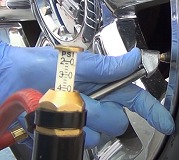Could you turn the rotors without the wheels installed? If not, you might suspect debris and corrosion built up inside the calipers. Forcing the pistons back in to make room for the new thicker pads can wedge the pistons against that crud. I always use a flat blade screwdriver to pry the pistons into the calipers before I unbolt them. You should never NEED a c-clamp to get the pistons in, as many people do.
If you didn't have the rotors machined, there is a point where rust buildup starts near the centers where the old pads weren't riding. New linings are commonly off-center a little compared to the old ones and can stick on that rust until it wears off.
If a caliper is rubbing on the inside of the wheel, check for rust buildup on the two outer fingers that contact the outer pad. Run a flat file over them to insure there's no high spots of rust or remnants of that glue some people use to prevent squealing. (Do that on the pistons too where they contact the inner pads). You're not trying to shine them up. You're just removing any high spots so the pads sit squarely.
Compare the new pads to the old ones. Very often there's standard and heavy duty brakes for one model for one year. Usually you won't be able to install the wrong pads even with a shoehorn and dynamite, but compare them anyway. Loosen the locked up wheel's lug nuts two turns, then try to turn the wheel. If that frees them up, you may have pads from an aftermarket supplier that got a little exuberant and thought if thick pads were a good deal for you, thicker pads would be a better deal. You could verify that by installing only the new inner pad and leaving the old outer pad in there. If the wheel turns freely, switch them and install just the new outer pad and the old inner one. If the wheel is stuck now, you'll know it's the outer pad causing it. There isn't much material that can be machined off the rotor and still maintain the minimum legal thickness, but that machining might reduce it's thickness enough to prevent the binding. Mechanics normally don't cut any more off than necessary to true them up, but anything removed from the outer surface will bring the caliper in away from the wheel.
There is usually a ridge of rust on both sides of the rotor at the far outer edge where the old pads weren't riding. That gets removed during the machining process, and it's not there with new rotors. The new linings can be off-center compared to the old ones and can ride on that rust. That has the same effect as installing linings that are 1/16" thicker than they're supposed to be. If you're not going to have the rotors machined, (something no professional would even consider), you may be able to wear that rust off by running the car in gear, jacked up, with the wheels off, and applying the brakes a few times. You can also use a flat file or small air cutoff tool as a grinder to remove that rust.
Check for doubled-up noise-cancelling shims on the pads' backing plates. I prefer using none but if they're supplied with the pads they should be stuck or clipped on. I've heard of a few instances where a pack of shims was packed with the new pads, but there were already shims riveted on from the factory. I suspect they were switching over from one style to another and a few boxes had both. If the clearance between the caliper and wheel is tight enough, a second shim could push the caliper out enough to rub.
Don't overlook a sloppy wheel bearing assembly. Normally they cause a buzzing noise long before they get sloppy but if they are, that will allow the wheel to tip in on top and rub on the caliper. The clue there is the wheel will likely spin normally while the car is jacked up, but not when it's on the ground.
Wednesday, January 9th, 2013 AT 10:11 AM


